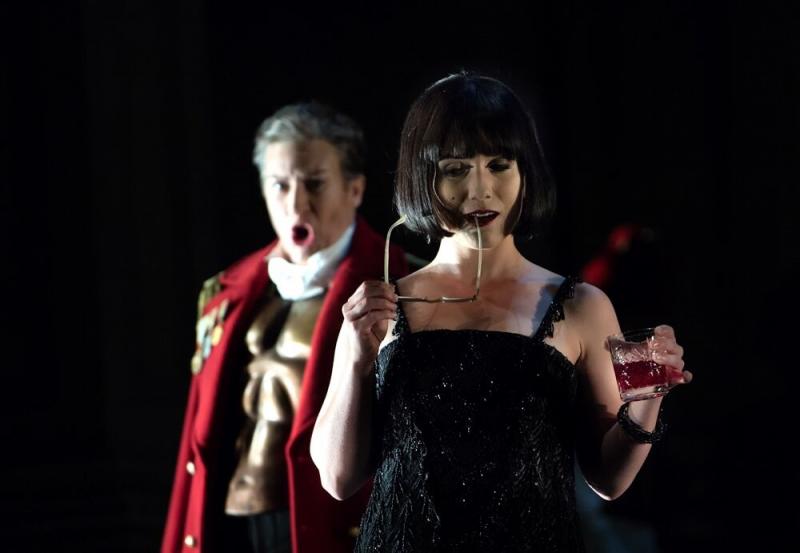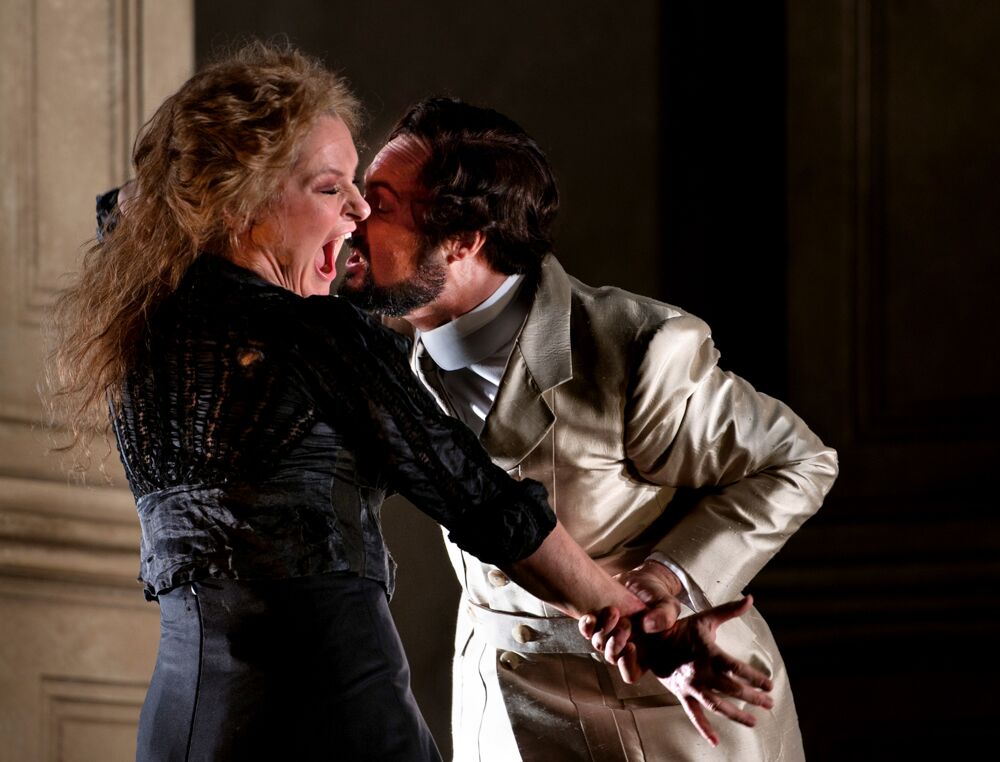Giulio Cesare, Glyndebourne review - no weak link | reviews, news & interviews
Giulio Cesare, Glyndebourne review - no weak link
Giulio Cesare, Glyndebourne review - no weak link
Glyndebourne at its best just got better

What a great show, on every level. David McVicar’s Glyndebourne production of Handel’s Giulio Cesare, originally staged in 2005, and in its third revival this year, has a cast without a weak link, and never fails to draw in the audience to the work’s cycles of power, suffering, death and intermittent triumph.
The big change from the previous seasons is that the production has a new Cleopatra. The role was originally offered for 2005 to Rosemary Joshua but memorably taken in all three previous showings of the piece, in 2005, 2006 and 2009, by Danielle de Niese. In Joélle Harvey, also an American, it has its new star. She has a fine, agile voice and a compelling stage presence which holds the attention naturally, without anything effortful about it. And she can definitely dance. She also brought deep pathos to her Act 3 aria “Piangerò la sorte mia”, aided by a wonderfully supportive and lyrical flute line from Lisa Beznosiuk.  Patricia Bardon (pictured above with Christophe Dumaux) was deeply affecting as Cornelia, one of those roles with far more than its fair share of suffering; Anna Stéphany was vocally superb and dramatically convincing as the revenge-seeking son Sesto, John Moore commanded attention as the out-and-out villain Achilla and Christophe Dumaux cunningly brought out the many sides of the complex character Tolomeo. And in a title role which she has made her own, Sarah Connolly never failed to bring dramatic truth and musicality to every moment.
Patricia Bardon (pictured above with Christophe Dumaux) was deeply affecting as Cornelia, one of those roles with far more than its fair share of suffering; Anna Stéphany was vocally superb and dramatically convincing as the revenge-seeking son Sesto, John Moore commanded attention as the out-and-out villain Achilla and Christophe Dumaux cunningly brought out the many sides of the complex character Tolomeo. And in a title role which she has made her own, Sarah Connolly never failed to bring dramatic truth and musicality to every moment.
Just one example of the way the combination of fine singing and acting work so well together with the care and the detail in this production was in Cesare’s aria “Aure, deh, per pietà spirate”. The really hard ask in Handel is to sustain a mood – in this instance of pain and sorrow – right through the da capo. All I know is that I shall remember for a very long time quite how touchingly Connolly sang the words “dar conforte al mio dolor”, the sadness of Caesar finding its focus as she contemplated a dead soldier on a battlefield.  I also found myself simply mesmerized by the perfect pacing which conductor William Christie now brings to the piece. Back in 2005, unless my memory is playing tricks, he would seek out devil-may-care excitement by occasionally teasing out the ritardando endings, stretching them out like pieces of tantric chewing gum, making life hard for the players from the Orchestra of the Age of Enlightenment – and more or less impossible for the singers. All that has gone. Christie in 2018 is a thoroughly benign force, an enabler; everything just seems so much more natural. He said in an interview five years ago that he would like to be remembered as having “given some people some solace, hope or enjoyment." A resounding yes to all of those.
I also found myself simply mesmerized by the perfect pacing which conductor William Christie now brings to the piece. Back in 2005, unless my memory is playing tricks, he would seek out devil-may-care excitement by occasionally teasing out the ritardando endings, stretching them out like pieces of tantric chewing gum, making life hard for the players from the Orchestra of the Age of Enlightenment – and more or less impossible for the singers. All that has gone. Christie in 2018 is a thoroughly benign force, an enabler; everything just seems so much more natural. He said in an interview five years ago that he would like to be remembered as having “given some people some solace, hope or enjoyment." A resounding yes to all of those.
The creative team of director David McVicar, set designer Robert Jones, costume designer Brigitte Reiffenstuel, lighting director Paule Constable and choreographer Andrew George were loudly and rightly cheered for their work as a cohesive team, bringing endless variety and helping the story to be told (the final scene pictured above). This production is Glyndebourne’s best-seller. And it just got better.
rating
Explore topics
Share this article
The future of Arts Journalism
You can stop theartsdesk.com closing!
We urgently need financing to survive. Our fundraising drive has thus far raised £49,000 but we need to reach £100,000 or we will be forced to close. Please contribute here: https://gofund.me/c3f6033d
And if you can forward this information to anyone who might assist, we’d be grateful.

Subscribe to theartsdesk.com
Thank you for continuing to read our work on theartsdesk.com. For unlimited access to every article in its entirety, including our archive of more than 15,000 pieces, we're asking for £5 per month or £40 per year. We feel it's a very good deal, and hope you do too.
To take a subscription now simply click here.
And if you're looking for that extra gift for a friend or family member, why not treat them to a theartsdesk.com gift subscription?
more Opera
 La bohème, Opera North review - still young at 32
Love and separation, ecstasy and heartbreak, in masterfully updated Puccini
La bohème, Opera North review - still young at 32
Love and separation, ecstasy and heartbreak, in masterfully updated Puccini
 Albert Herring, English National Opera review - a great comedy with depths fully realised
Britten’s delight was never made for the Coliseum, but it works on its first outing there
Albert Herring, English National Opera review - a great comedy with depths fully realised
Britten’s delight was never made for the Coliseum, but it works on its first outing there
 Carmen, English National Opera review - not quite dangerous
Hopes for Niamh O’Sullivan only partly fulfilled, though much good singing throughout
Carmen, English National Opera review - not quite dangerous
Hopes for Niamh O’Sullivan only partly fulfilled, though much good singing throughout
 Giustino, Linbury Theatre review - a stylish account of a slight opera
Gods, mortals and monsters do battle in Handel's charming drama
Giustino, Linbury Theatre review - a stylish account of a slight opera
Gods, mortals and monsters do battle in Handel's charming drama
 Susanna, Opera North review - hybrid staging of a Handel oratorio
Dance and signing complement outstanding singing in a story of virtue rewarded
Susanna, Opera North review - hybrid staging of a Handel oratorio
Dance and signing complement outstanding singing in a story of virtue rewarded
 Ariodante, Opéra Garnier, Paris review - a blast of Baroque beauty
A near-perfect night at the opera
Ariodante, Opéra Garnier, Paris review - a blast of Baroque beauty
A near-perfect night at the opera
 Cinderella/La Cenerentola, English National Opera review - the truth behind the tinsel
Appealing performances cut through hyperactive stagecraft
Cinderella/La Cenerentola, English National Opera review - the truth behind the tinsel
Appealing performances cut through hyperactive stagecraft
 Tosca, Royal Opera review - Ailyn Pérez steps in as the most vivid of divas
Jakub Hrůša’s multicoloured Puccini last night found a soprano to match
Tosca, Royal Opera review - Ailyn Pérez steps in as the most vivid of divas
Jakub Hrůša’s multicoloured Puccini last night found a soprano to match
 Tosca, Welsh National Opera review - a great company reduced to brilliance
The old warhorse made special by the basics
Tosca, Welsh National Opera review - a great company reduced to brilliance
The old warhorse made special by the basics
 BBC Proms: The Marriage of Figaro, Glyndebourne Festival review - merriment and menace
Strong Proms transfer for a robust and affecting show
BBC Proms: The Marriage of Figaro, Glyndebourne Festival review - merriment and menace
Strong Proms transfer for a robust and affecting show
 BBC Proms: Suor Angelica, LSO, Pappano review - earthly passion, heavenly grief
A Sister to remember blesses Puccini's convent tragedy
BBC Proms: Suor Angelica, LSO, Pappano review - earthly passion, heavenly grief
A Sister to remember blesses Puccini's convent tragedy
 Orpheus and Eurydice, Opera Queensland/SCO, Edinburgh International Festival 2025 review - dazzling, but distracting
Eye-popping acrobatics don’t always assist in Gluck’s quest for operatic truth
Orpheus and Eurydice, Opera Queensland/SCO, Edinburgh International Festival 2025 review - dazzling, but distracting
Eye-popping acrobatics don’t always assist in Gluck’s quest for operatic truth

Add comment